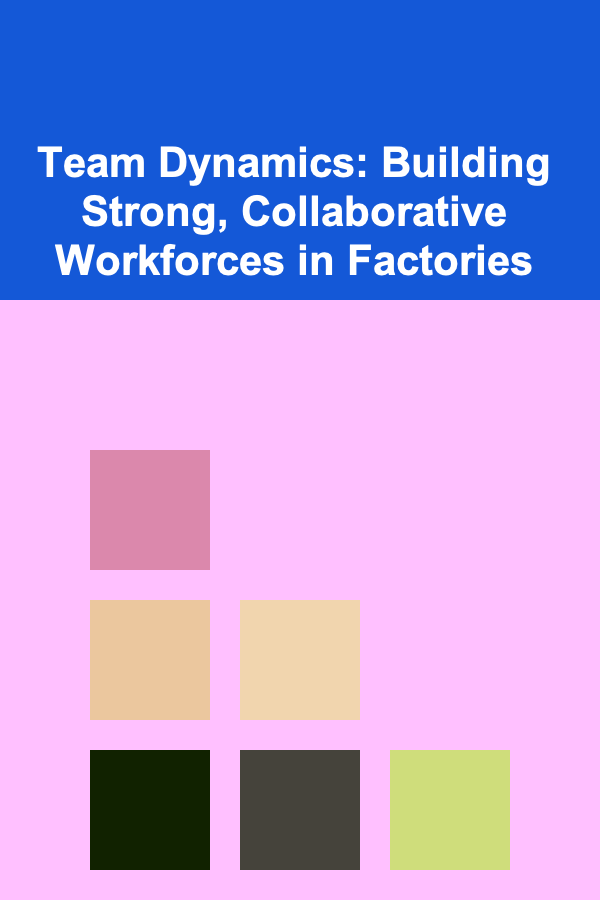
Team Dynamics: Building Strong, Collaborative Workforces in Factories
ebook include PDF & Audio bundle (Micro Guide)
$12.99$11.99
Limited Time Offer! Order within the next:

In the high-stakes world of factory production, where speed, precision, and efficiency are paramount, one often-overlooked element plays a critical role in achieving success: team dynamics. The relationships and interactions between employees, supervisors, and management can significantly impact productivity, safety, and overall company performance. Building a collaborative, strong workforce is more than just putting the right people in the right positions; it's about fostering an environment that encourages trust, communication, and cooperation among all team members.
A factory workforce that works well together can overcome challenges more easily, innovate faster, and deliver high-quality results. In contrast, poor team dynamics can lead to misunderstandings, mistakes, and inefficiencies. In this actionable guide, we explore key strategies that factory leaders can use to build strong, collaborative teams that will drive success in the workplace.
Foster a Culture of Trust and Respect
The foundation of any strong team is trust. In a factory setting, where employees are often tasked with complex, high-pressure work, trust is essential. When employees trust each other, they are more likely to communicate openly, collaborate on solving problems, and support each other in achieving common goals.
Actionable Steps:
- Lead by Example: Supervisors and managers must set the tone by demonstrating trustworthiness, transparency, and respect in their own interactions. When leaders model these behaviors, employees are more likely to mirror them.
- Encourage Open Communication: Create an environment where team members feel safe sharing their ideas, concerns, and feedback. Hold regular team meetings where employees can discuss challenges and brainstorm solutions without fear of judgment.
- Recognize Contributions: Acknowledge individual and team efforts regularly. Public recognition, even for small achievements, reinforces the value of teamwork and shows respect for everyone's role in the process.
By promoting a culture where trust and respect are prioritized, factory leaders can lay the groundwork for a cohesive, cooperative team.
Build Effective Communication Channels
In a factory setting, where work is often fast-paced and tasks are complex, effective communication is crucial. Misunderstandings or miscommunications can lead to delays, errors, or safety issues. It's essential to implement systems that ensure clear, consistent, and timely communication among all team members.
Actionable Steps:
- Establish Clear Communication Protocols: Develop standardized communication procedures for all levels of the workforce. This includes having clear instructions for reporting issues, providing feedback, and sharing updates on production.
- Use Technology to Enhance Communication: Implement digital communication tools such as team messaging apps or production management software. These tools help provide instant updates and facilitate quick problem-solving in real time.
- Encourage Active Listening: Teach employees the importance of active listening. Encourage them to not only speak up when they have concerns or ideas but to also listen attentively to their peers, creating a more collaborative environment.
When communication flows smoothly, teams can avoid unnecessary mistakes, reduce downtime, and respond more quickly to emerging challenges.
Promote Collaboration Through Cross-Functional Teams
Factory work is often divided into specialized tasks, but true success comes from the ability to collaborate across different areas of the production process. Encouraging cross-functional teams can break down silos and promote knowledge sharing, leading to more efficient problem-solving and better overall performance.
Actionable Steps:
- Create Multi-Disciplinary Teams: Form teams that include individuals from different areas of expertise, such as operations, maintenance, and quality control. This encourages diverse perspectives and leads to more innovative solutions to challenges.
- Cross-Train Employees: Provide opportunities for employees to learn about different roles within the factory. This not only increases flexibility but also improves communication between departments as everyone gains a better understanding of how the factory as a whole operates.
- Hold Collaborative Workshops: Organize regular workshops or team-building exercises that encourage employees from different teams to work together on problem-solving or process improvement activities.
By breaking down functional barriers and encouraging cross-functional collaboration, factory teams can work more seamlessly together and solve problems more effectively.
Develop Strong Leadership at All Levels
Leadership doesn't start and end with supervisors or managers. Every team member plays a role in the leadership dynamics of a factory, from team leads to frontline employees. Empowering employees to take on leadership roles within their teams creates a sense of ownership and encourages everyone to contribute to the team's success.
Actionable Steps:
- Identify Potential Leaders: Look for employees who exhibit leadership qualities such as initiative, problem-solving skills, and the ability to motivate others. Provide them with opportunities for development, whether through mentorship, training, or taking on leadership responsibilities within small teams.
- Provide Leadership Training: Offer training for both formal and informal leaders within the team. This can include communication skills, conflict resolution, decision-making, and team management techniques.
- Encourage Peer Leadership: Encourage employees to take on leadership roles within their own teams, even if they are not officially designated as team leaders. Peer leadership can help build trust and foster a sense of responsibility among employees.
By developing leadership at all levels, factory supervisors can create a more dynamic, proactive team where everyone feels empowered to contribute to the success of the workforce.
Encourage Accountability and Shared Goals
Accountability is essential in any high-performance team. When individuals understand that they are responsible for their own performance and that their contributions impact the success of the team, they are more likely to stay motivated and engaged. Additionally, fostering a culture of shared goals ensures that everyone is working towards the same objectives.
Actionable Steps:
- Set Clear Expectations: Clearly define the roles, responsibilities, and expectations for each team member. This ensures that everyone understands their contributions to the team's success and avoids any confusion about duties.
- Use Key Performance Indicators (KPIs): Track team performance using KPIs that align with the factory's overall goals. This could include production targets, quality metrics, and safety standards. Ensure that these KPIs are visible to the entire team and are regularly reviewed.
- Promote Collective Success: Focus on team achievements rather than individual performance. Celebrate milestones and successes as a group, reinforcing the idea that everyone's contributions are integral to the factory's success.
When employees are held accountable and understand the collective nature of their work, they are more likely to collaborate and contribute to shared goals.
Resolve Conflicts Constructively
In any team environment, conflicts are inevitable. However, how conflicts are addressed can either strengthen or damage team dynamics. Factory supervisors must be prepared to address conflicts in a way that promotes understanding, resolution, and growth.
Actionable Steps:
- Address Issues Early: Don't allow conflicts to fester. Encourage open dialogue as soon as issues arise, and address them before they escalate. A timely intervention can prevent long-term disruptions.
- Use Mediation Techniques: Train managers and team leads in conflict resolution techniques, such as mediation. This allows them to act as neutral parties, helping employees find common ground and come to a resolution that benefits the team.
- Promote a Solutions-Oriented Approach: Encourage team members to focus on finding solutions rather than placing blame. By framing conflicts as opportunities for growth, supervisors can help build a more resilient, cohesive team.
A proactive, solution-oriented approach to conflict resolution can improve team dynamics by fostering trust and mutual respect among workers.
Invest in Team Building and Employee Engagement
The strength of a team is not only determined by its skills but also by the level of engagement and camaraderie among its members. Factory leaders must invest time and effort into team-building activities that promote connection, collaboration, and mutual support.
Actionable Steps:
- Organize Team Building Activities: Host regular team-building exercises that allow employees to bond outside of the production environment. This could include outings, group challenges, or collaborative workshops.
- Encourage Social Interaction: Create opportunities for employees to interact in a non-work context. This could be through social events, shared break spaces, or team lunches.
- Gather Feedback and Act on It: Regularly survey employees about their experience working in the team. Act on the feedback you receive, making adjustments to improve morale and team collaboration.
By investing in employee engagement and team-building activities, supervisors can create an environment where employees feel connected, valued, and motivated to contribute to the team's success.
Conclusion
Building a strong, collaborative workforce in a factory environment is essential to achieving long-term success. By fostering trust, promoting effective communication, encouraging collaboration, developing leadership, and addressing conflicts constructively, factory leaders can create a team dynamic that drives productivity, safety, and innovation. A factory workforce that works together harmoniously will not only meet production goals but also continuously improve and adapt to meet the challenges of an ever-evolving industry. By prioritizing team dynamics, supervisors can unlock the full potential of their workforce, leading to improved outcomes for both the team and the organization as a whole.

How to Create a Sustainable Spending Plan for Long-Term Wealth
Read More
How to Design a Checklist for Managing Social Media Customer Service
Read More
How to Sell Handmade Pottery on Etsy: An Actionable Guide
Read More
How to Tackle a Whole-House Renovation Step by Step
Read More
How to Use Job Fairs to Your Advantage
Read More
How To Learn a Language on a Budget
Read MoreOther Products

How to Create a Sustainable Spending Plan for Long-Term Wealth
Read More
How to Design a Checklist for Managing Social Media Customer Service
Read More
How to Sell Handmade Pottery on Etsy: An Actionable Guide
Read More
How to Tackle a Whole-House Renovation Step by Step
Read More
How to Use Job Fairs to Your Advantage
Read More